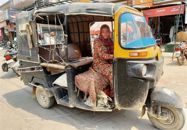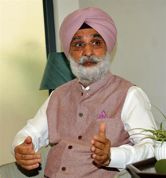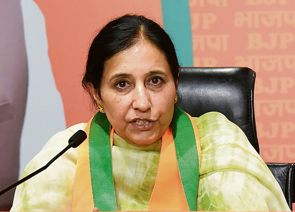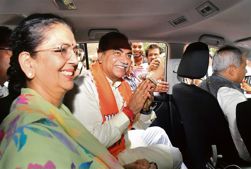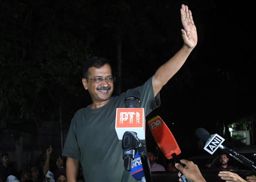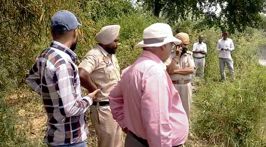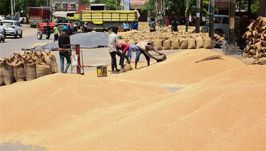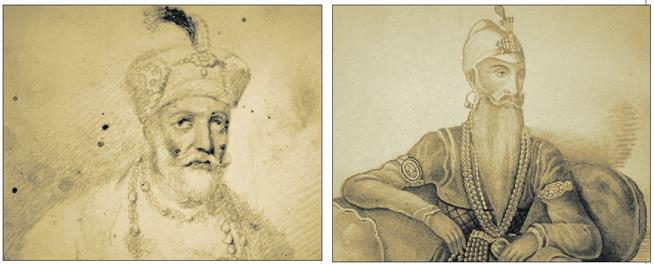
Portrait of Emperor Akbar II by Jiwan Ram, c. 1834. British Library, London; (right) Maharaja Ranjit Singh. Lithograph, dated 1834, based on a sketch by Jiwan Ram. From HT Prinsep’s ‘Origin of the Sikh Power
B N goswamy
None of Jiwan Ram’s portraits dates before the 1820s and his earlier career can only be guessed at, but as an Indian artist he surely would have been aware of the revolution in Delhi painting wrought by the patronage of the Fraser brothers and James Skinner. The stiffly formal and hieratic traditional portraits of princes and nobility had been transformed into more naturalistic renderings of the human figure… — JP Losty
…the Emperor (Akbar II) requested him (the painter) to remove the great blotch from under the nose. ‘May it please your majesty,’ said the painter, ‘it is impossible to draw any person without a shadow; and I hope many millions will continue to repose under that of your majesty.’ ‘True Rajah,’ said His Majesty, ‘men must have shadows; but there is surely no necessity for placing them immediately under their noses! The ladies will not allow mine to be put there; they say it looks as though I have been taking snuff all my life; and it certainly has a most filthy appearance, besides, it is all awry, as I told you when you began upon it!’ The rajah was obliged to remove the shadow from under the imperial and certainly very noble nose…
—William Sleeman in his
‘Rambles and Recollections’; 1834
For long years, the only thing I knew about the painter — whom I write about now — was an obscure reference to him by Emily Eden, the gifted sister of Lord Auckland who accompanied him on his travels to the Punjab. She, a painter herself, spoke in her account of a ‘native painter’, ‘Jiun Ram’, whose work she had liked, being ‘the best’ among portraits made at the meeting between Lord Bentinck and the Maharaja of Punjab at Ropar in 1831. Nothing more than this: no details about where he came from, no firm dates, no signed work of his. Even now, virtually all that I know about him is through the writing of Jerry Losty — tireless and learned curator of Indian visual materials at the British Library, who sadly passed away recently — who trained light on Jiwan Ram’s distinguished work in a long article, much as he had done on another talented but virtually unknown painter, Sita Ram, earlier.

There was a time in the second quarter of the 19th century when Jiwan Ram’s name had acquired considerable currency. This, not because he was a great painter of miniatures in the Indian, chiefly late Mughal, style — he did know the genre, of course, and had worked in it for some time — but because he learnt to paint in oils, European fashion, and turned his gifted hand to painting portraits, mostly of ranked officers then serving in the East India Company. There were others who patronised him, one knows: the Mughal emperor, Akbar II (ruled 1806-1837), among the last of a great line — whose exchange with the painter about the shadow under his nose in the portrait I have cited above — from whom he had received the title ‘Raja’, for one; the redoubtable Begum Samru of Sardhana, for another. But it were the officers of the East India Company, chiefly, who seem to have turned to Jiwan Ram to have their portraits painted. The names read as if from a roll call of honour: lieutenants and captains and colonels painted in their dazzling uniforms — Robert McMullin, William Garden, Robert Smith, Edmund Cartwright, Sir Thomas McMahon. There were European painters active at that time in India too — George Chinnery, for instance, Robert Home, William Melville, George Beechey, Charles D’Oyly — but Jiwan Ram appears to have been the preferred artist for many. One sees him now in Delhi, now in Patna; Meerut was a place he greatly favoured, but he was quick to move to Sardhana or Agra when patronage beckoned. Slowly, after having learnt the technique of painting in oils, Jiwan Ram worked out a style that could be recognised almost at sight: dark background, figure up to the waist, face seen from close. Describing his signed 1827 portrait of Captain McMullin, against the background of a church at Meerut, Losty speaks of Jiwan Ram having portrayed ‘a dashing Irishman, his left hand holding his sword hilt and the right the brim of his hat, with his eyes fixed on something to the left of the viewer’. Occasionally, one espies an air of patronising superiority creeping into a description by contemporary Englishmen of Jiwan Ram’s work — consider, for instance, the note by Captain Mundy, who was ADC to Lord Combermere, on a portrait of Begum Samru which had been sent as a gift by the Begum to Mundy’s master: “The picture, a work of a native artist who resides at Meerut, and has made respectable progress in the art, was an exceeding good likeness; and my fingers always itched to transform her hookah-snake into a broom…” — but as a matter of course Jiwan Ram’s work was held in high esteem. This esteem, one might add, continues to survive: why else would, today, the British Library or the Regents of the Oxford University announce with a sense of great satisfaction their having managed to add works by Raja Jiwan Ram to their collections?
There certainly are gaps that remain in our information about Jiwan Ram. For instance, where was he from? Delhi? Meerut? When was he born and till how long did he remain active? Who did he train under as far as painting in oils was concerned? Did he always remain a freelance artist, or did he have stable employment under someone, even if for a few years? While one searches for answers, there is at least one little puzzle that I think I can solve. Losty says at one point that from an inscription in Urdu on a painting of his, “we learn that Jivan Ram was the son of one Bafalji and was a resident of Delhi, but it is poorly written with many of the dots omitted so that his father’s name is provisional. It was first read as Tulchi…” For me, the name of his father, as noted in this inscription, clearly reads “La’alji”, and neither as “Bafalji”, nor “Tulchi”.
Join Whatsapp Channel of The Tribune for latest updates.






